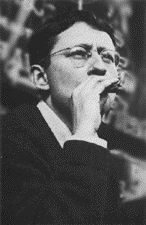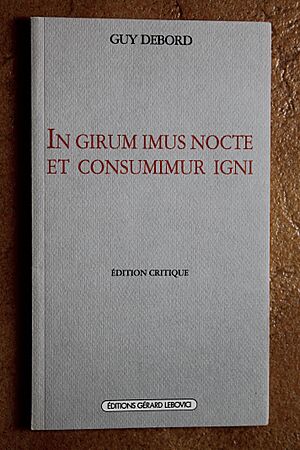Guy Debord facts for kids
Quick facts for kids
Guy Debord
|
|
|---|---|
 |
|
| Born |
Guy Ernest Debord
28 December 1931 Paris, France
|
| Died | 30 November 1994 (aged 62) Bellevue-la-Montagne, Haute-Loire, France
|
| Education | University of Paris (no degree) |
| Era | 20th-century philosophy |
| Region | Western philosophy |
| School | Continental philosophy Letterist International Situationist Western Marxism/Ultra-left |
|
Main interests
|
Class struggle Commodity fetishism Reification Social alienation Social theory |
|
Notable ideas
|
Dérive Détournement Psychogeography Recuperation Spectacle |
|
Influences
|
|
|
Influenced
|
|
| Signature | |
 |
|
Guy-Ernest Debord (born December 28, 1931 – died November 30, 1994) was a French philosopher and filmmaker. He was a key thinker who criticized modern society. He also helped start important groups like the Letterist International and the Situationist International.
Debord is most famous for his 1967 book, The Society of the Spectacle. This book talked about how images and media control our lives.
Contents
Guy Debord's Life
Early Years
Guy Debord was born in Paris in 1931. His father passed away when Guy was young. His mother sent him to live with his grandmother in Italy.
During World War II, his family moved often. Debord went to high school in Cannes. There, he became interested in films and art.
As a young man, Debord was against the French war in Algeria. He joined protests in Paris. He studied law at the University of Paris but left before finishing. After that, he started his career as a writer.
Joining the Lettrists
Debord joined a group called the Lettrists when he was 18. This group was interested in new ideas about art and writing. Later, Debord became a leader of a part of this group called the Letterist International.
In the 1960s, Debord led another group, the Situationist International. This group had a big impact on the Paris Uprising of 1968. During this time, Debord took part in protests at the Sorbonne university. Many people think his book The Society of the Spectacle helped inspire these protests.
Starting the Situationist International
In 1957, several art groups came together in Italy. They formed the Situationist International (SI). Debord was a main leader from the Letterist group.
At first, the SI focused on criticizing art. They believed art had lost its true meaning. They even raided an art conference in Belgium in 1958. This event got a lot of media attention. The SI also tried to create "industrial painting." This was art made in large amounts to challenge how people valued unique artworks. Debord was very involved in planning these actions.
The Situationists' Political Ideas
In 1967, Debord published The Society of the Spectacle. This book, along with articles from the SI's journal, explained their main idea: the "spectacle."
The Situationists believed the "spectacle" was how powerful people used images and media to control society. They said that in modern times, "all that was once lived has moved into representation." This means real experiences were replaced by images and appearances. This idea greatly influenced the protests in France in May 1968. Many protest slogans came from Situationist writings.
Later Life and Interests
In 1972, Debord ended the Situationist International. Many original members had left or been removed. After this, Debord focused on making films. He received money from a publisher named Gérard Lebovici.
Debord then lived a quiet life in a cottage with his second wife, Alice Becker-Ho. He spent his time reading and writing. He was very interested in war strategies, studying thinkers like Clausewitz and Sun Tzu. He even designed a war game with Alice Becker-Ho.
Death
Before he passed away, Debord made a documentary called Son art et son temps (His Art and His Times). This film was about his life and social issues in Paris in the 1990s. Guy Debord died on November 30, 1994.
Guy Debord's Works
Written Works
Guy Debord's most famous books are The Society of the Spectacle and Comments on the Society of the Spectacle. He also wrote books about his own life, like Mémoires. He wrote many shorter pieces for different journals.
In The Society of the Spectacle, Debord described the "spectacle" as false images that control our real lives. He saw it as a way the world is presented to us, making us think and act in certain ways.
Debord was worried about how governments and media controlled daily life. He felt that mass production and buying things took away people's freedom. He criticized both capitalism (like in the West) and strict communism (like in the Eastern Bloc). He believed both systems limited what individuals could do.
Debord argued that people felt more and more disconnected from their true selves. This was because of the powerful "spectacle" of mass media and advertisements. He saw the spectacle as a system that controls society by itself.
Debord's first book, Mémoires, had a sandpaper cover. This was so it would damage other books placed next to it, showing his rebellious spirit.
Films
Debord became interested in films when he was young. He said he often left movies early because they bored him. When he joined the Lettrists, they even tried to cause trouble for Charlie Chaplin's visit to Paris with their negative reviews.
Debord challenged how films were usually made. He wanted his audience to think and interact with the movie, not just watch it. For example, his film Hurlements only shows black and white screens. It has silence with a little bit of talking.
His first film, Hurlements en faveur de Sade (Howls for Sade), was made in 1952. It had no images, only bright white screens when someone spoke and black screens when there was silence. The film ended with 24 minutes of black silence. People often got angry and left when watching it. The script used quotes from different sources, put together in a mixed-up way.
Later, with financial help, Debord made a second film. It mixed scenes of his friends with scenes from mass media. This idea of combining his world with mass media became a big theme in his work, leading up to "The Society of the Spectacle." Debord said his book The Society of the Spectacle was "already written like a script."
His last film, "Son Art et Son Temps," was released after his death. It was like a final statement where Debord looked back at his work and the culture of his time.
Here are some of his films:
- Hurlements en faveur de Sade (Howls for Sade) 1952
- Sur le passage de quelques personnes à travers une assez courte unité de temps (On the Passage of a Few Persons Through a Rather Brief Unity of Time) 1959
- Critique de la séparation (Critique of Separation) 1961
- La Société du spectacle (Society of the Spectacle) 1973
- Réfutation de tous les jugements, tant élogieux qu'hostiles, qui ont été jusqu'ici portés sur le film " La Société du spectacle " (Refutation of All the Judgements, Pro or Con, Thus Far Rendered on the Film "The Society of the Spectacle") 1975
- In girum imus nocte et consumimur igni (a Latin palindrome meaning "We Go Round and Round in the Night, and Are Consumed by Fire") 1978 – This film was meant to be Debord's last and was largely about his own life.
- Guy Debord, son art, son temps (Guy Debord – His Art and His Time) 1994
Guy Debord's Legacy
In 2009, the French Minister of Culture called Debord's works a "national treasure." This was because Yale University wanted to buy his archives. The Ministry stated that he was "one of the most important contemporary thinkers."
Debord himself once called The Society of the Spectacle "the most important book of the twentieth century." He is still seen as a very important and sometimes controversial figure, especially among scholars who study radical politics and modern art in Europe.
See also
 In Spanish: Guy Debord para niños
In Spanish: Guy Debord para niños


